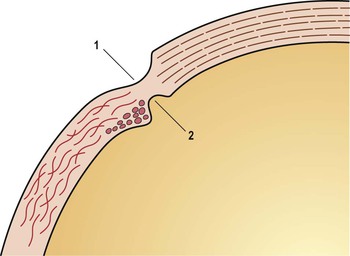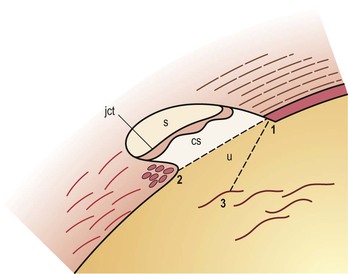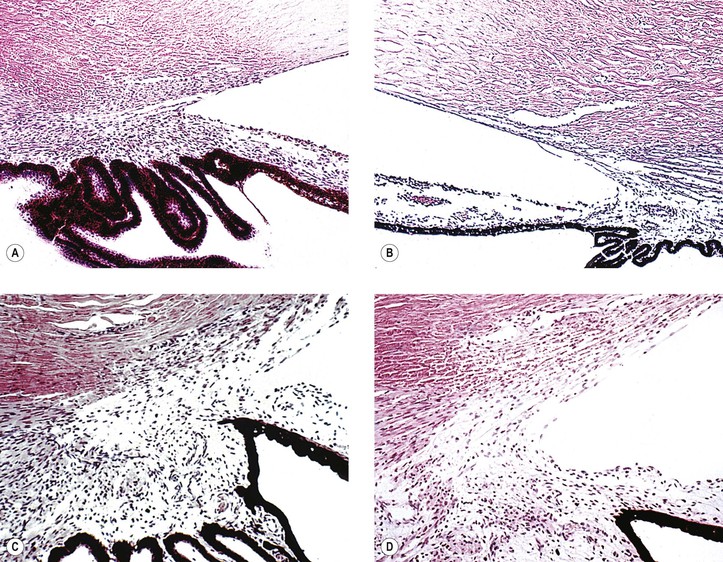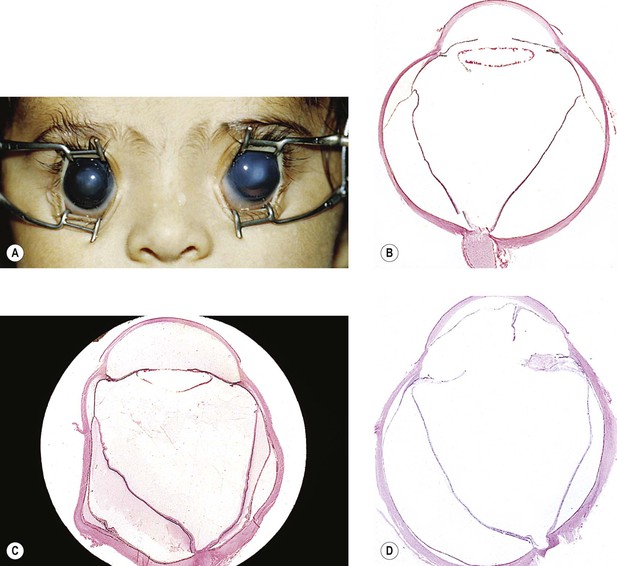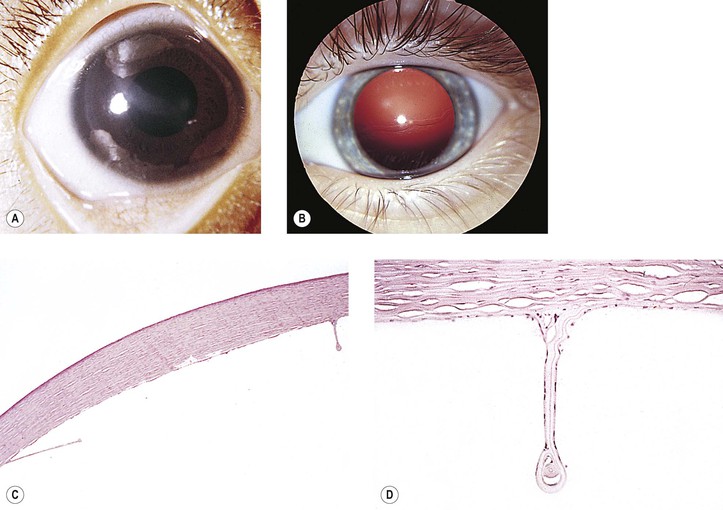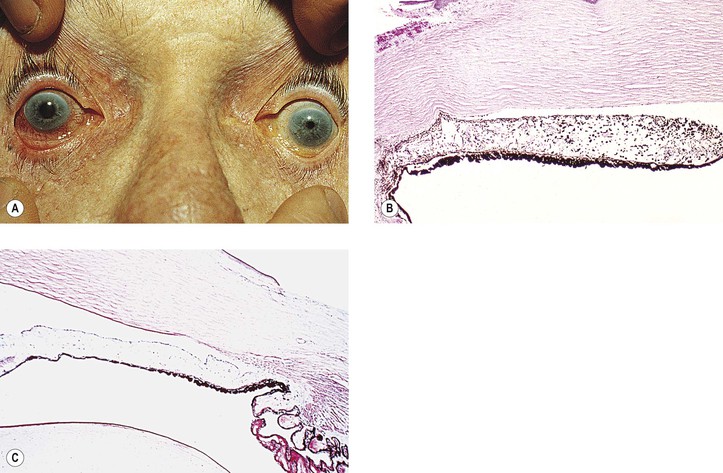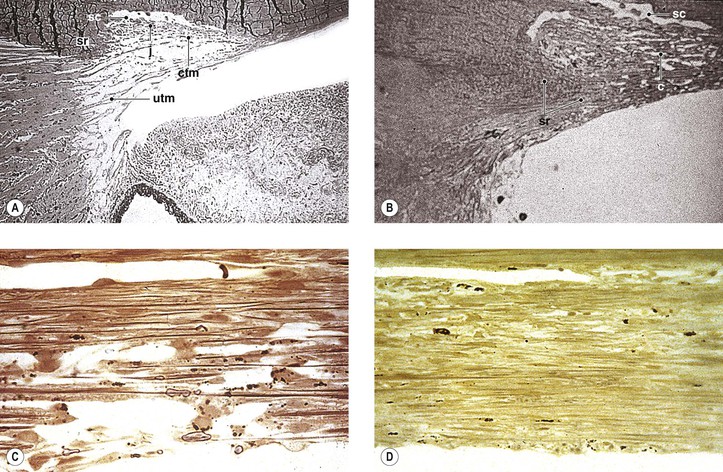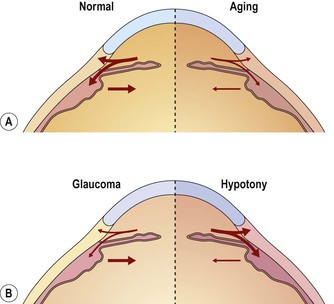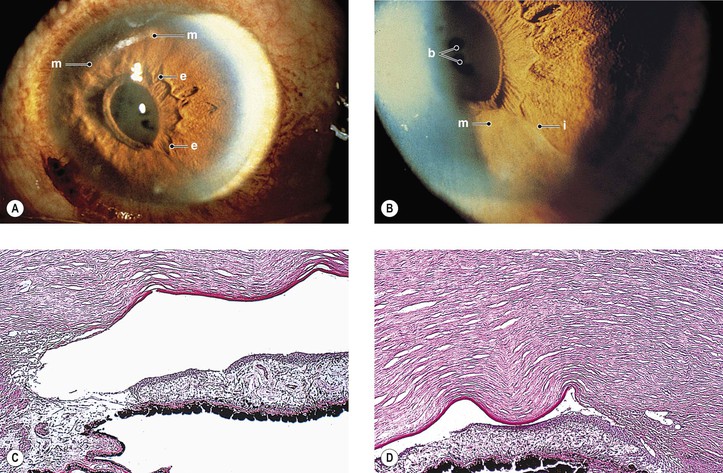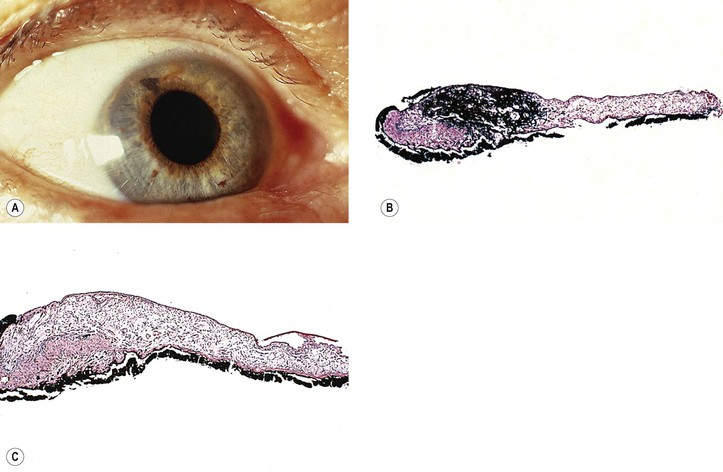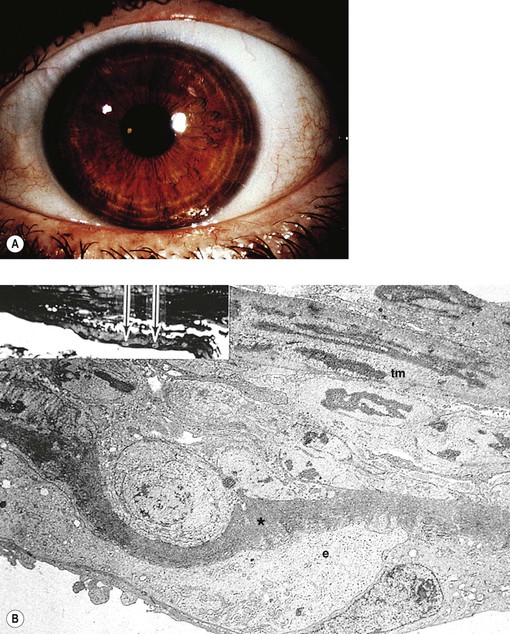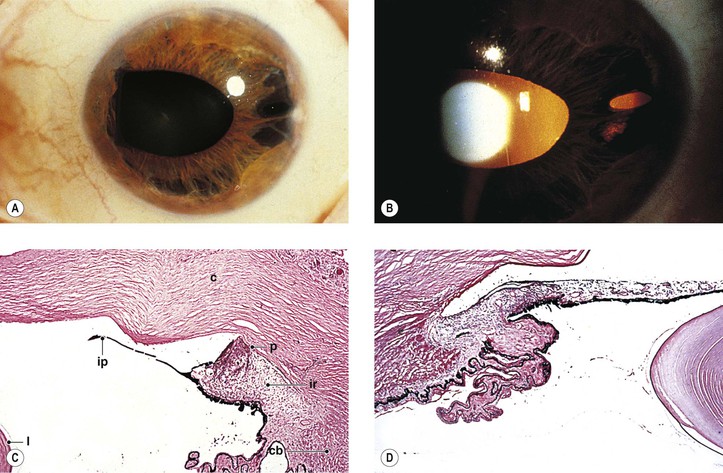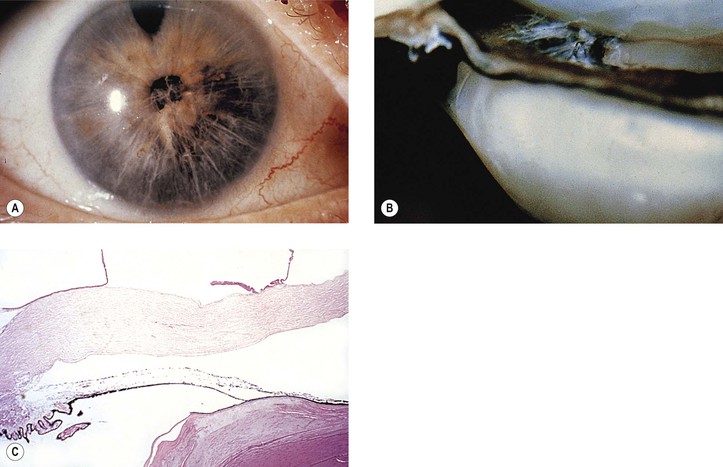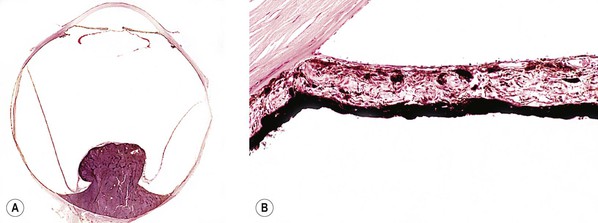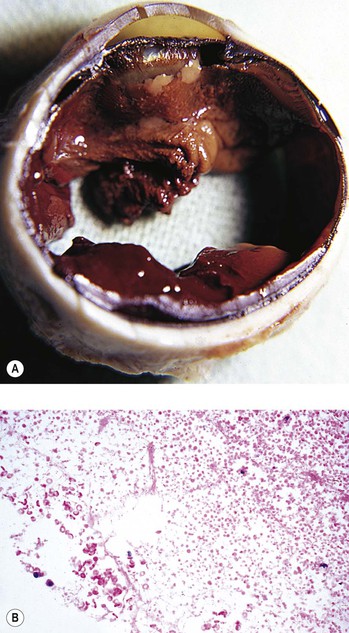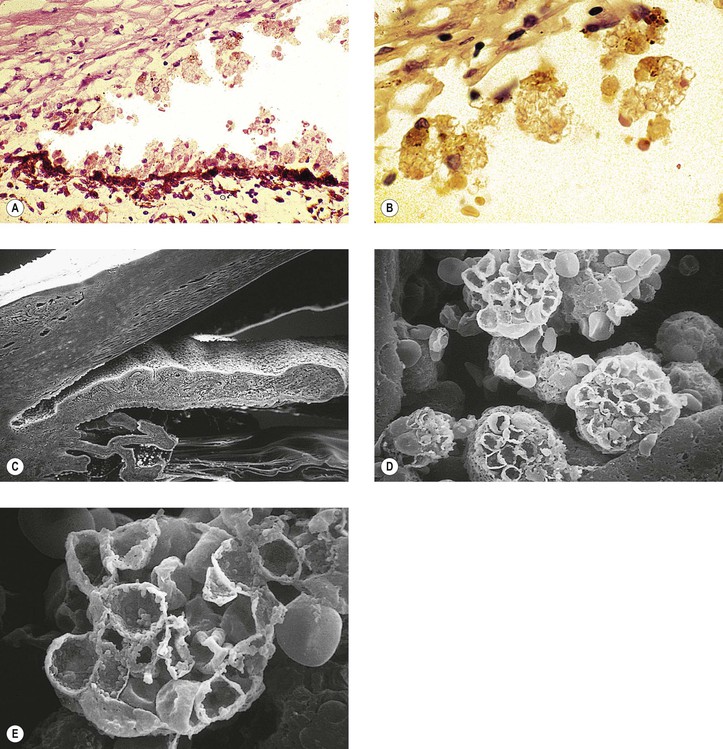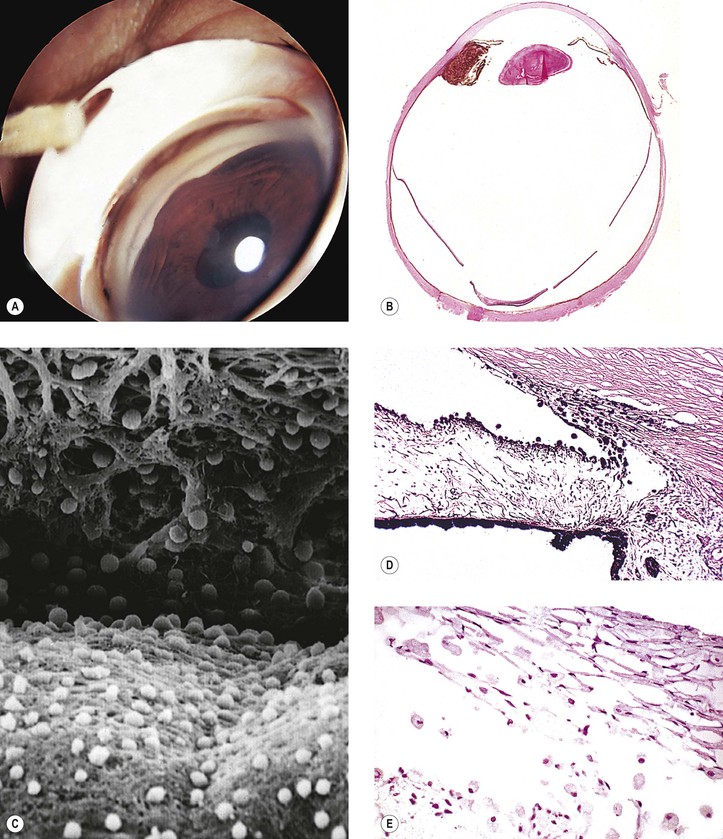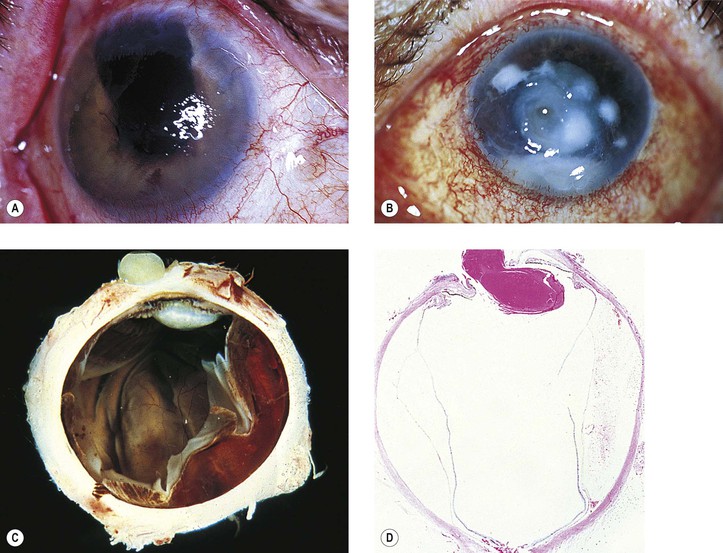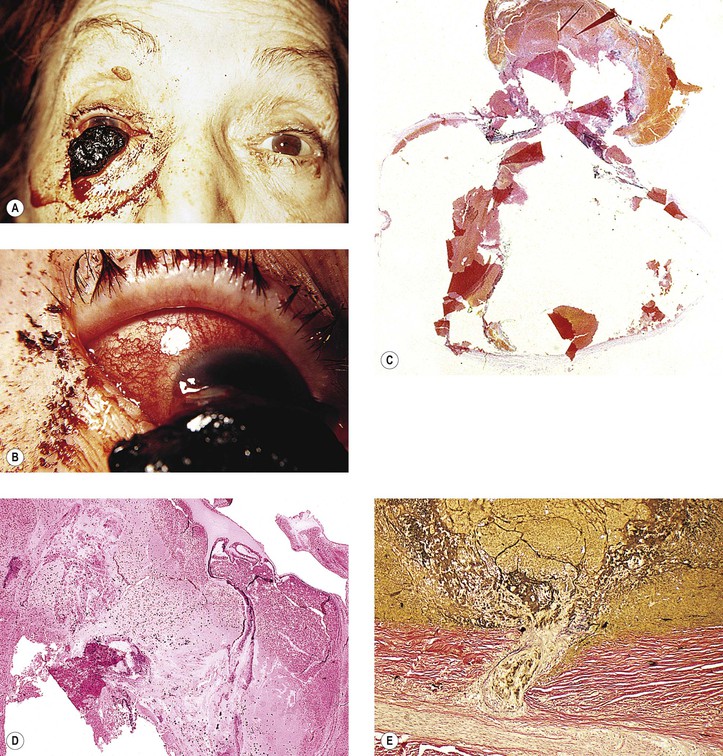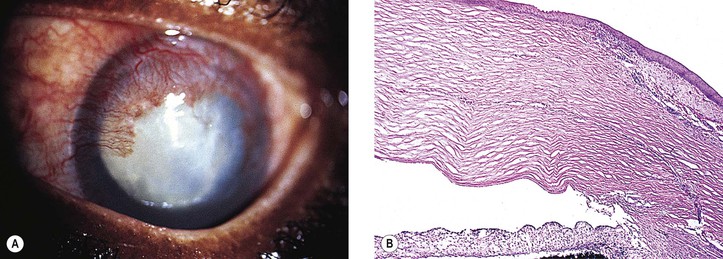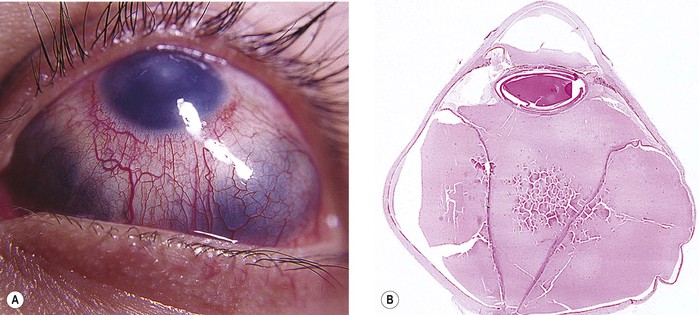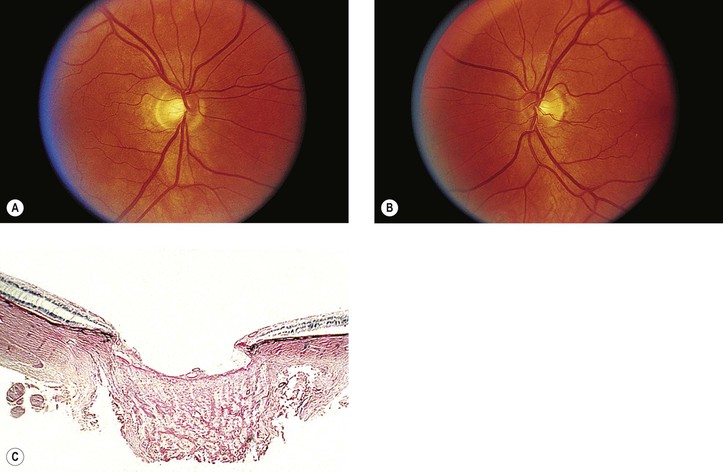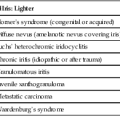Bibliography
Normal Anatomy
Dietlein TS, Luke C, Jacobi PC, et al. Individual factors influencing trabecular morphology in glaucoma patients undergoing filtration surgery. J Glaucoma. 2002;11:197.
Fine BS, Yanoff M. Ocular Histology: A Text and Atlas. 2nd edn. Harper & Row: Hagerstown, PA; 1979.
Gould DB, Smith RS, John SW. Anterior segment development relevant to glaucoma. Int J Dev Biol. 2004;48:1015.
Hamard P, Valtot F, Sourdille P, et al. Confocal microscopic examination of trabecular meshwork removed during ab externo trabeculectomy. Br J Ophthalmol. 2002;86:1046.
Hann CR, Springett MJ, Wang X, et al. Ultrastructural localization of collagen IV, fibronectin, and laminin in the trabecular meshwork of normal and glaucomatous eyes. Ophthalmic Res. 2001;33:314.
John SW, Anderson MG, Smith RS. Mouse genetics: A tool to help unlock the mechanisms of glaucoma. J Glaucoma. 1999;8:400.
Johnson M, Chan D, Read AT, et al. The pore density in the inner wall endothelium of Schlemm’s canal of glaucomatous eyes. Invest Ophthalmol Vis Sci. 2002;43:2950.
Jonas JB, Budde WM, Panda-Jones S. Ophthalmoscopic evaluation of the optic nerve head. Surv Ophthalmol. 1999;43:293.
Klenkler B, Sheardown H. Growth factors in the anterior segment: Role in tissue maintenance, wound healing and ocular pathology. Exp Eye Res. 2004;79:677.
Yanoff M, Fine BS. Ocular Pathology: A Color Atlas. 2nd edn. Gower Medical: New York; 1992.
Zhang X, Wang N, Schroeder A, et al. Expression of adenylate cyclase subtypes II and IV in the human outflow pathway. Invest Ophthalmol Vis Sci. 2000;41:998.
Introduction
Aghaian E, Choe JE, Lin S, et al. Central corneal thickness of Caucasians, Chinese, Hispanics, Filipinos, African Americans, and Japanese in a glaucoma clinic. Ophthalmology. 2004;111:2211.
Ahmed II, Feldman F, Kucharczyk W, et al. Neuroradiologic screening in normal-pressure glaucoma: Study results and literature review. J Glaucoma. 2002;11:279.
Aung T, Nolan WP, Machin D, et al. Anterior chamber depth and the risk of primary angle closure in 2 East Asian populations. Arch Ophthalmol. 2005;123:527.
Aung T, Rezaie T, Okada K, et al. Clinical features and course of patients with glaucoma with the E50K mutation in the optineurin gene. Invest Ophthalmol Vis Sci. 2005;46:2816.
Bashford KP, Shafranov G, Tauber S, et al. Considerations of glaucoma in patients undergoing corneal refractive surgery. Surv Ophthalmol. 2005;50:245.
Bennett SR, Alward WLM, Folberg R. An autosomal dominant form of low-tension glaucoma. Am J Ophthalmol. 1989;108:238.
Bosley TM, Hellani A, Spaeth GL, et al. Down-regulation of OPA1 in patients with primary open angle glaucoma. Mol Vis. 2011;17:1074.
Buono LM, Foroozan R, Sergott RC, et al. Is normal tension glaucoma actually an unrecognized hereditary optic neuropathy? New evidence from genetic analysis. Curr Opin Ophthalmol. 2002;13:362.
Burdon KP. Genome-wide association studies in the hunt for genes causing primary open-angle glaucoma: A review. Clin Experiment Ophthalmol. 2012;40:358.
Chang TC, Congdon NG, Wojciechowski R, et al. Determinants and heritability of intraocular pressure and cup-to-disc ratio in a defined older population. Ophthalmology. 2005;112:1186.
Chauhan BC, Hutchison DM, Leblanc RP, et al. Central corneal thickness and progression of the visual field and optic disc in glaucoma. Br J Ophthalmol. 2005;89:1008.
Colak D, Morales J, Bosley TM, et al. Genome-wide expression profiling of patients with primary open angle glaucoma. Invest Ophthalmol Vis Sci. 2012;53:5899.
Collaborative Normal-Tension Glaucoma Study Group. Natural history of normal-tension glaucoma. Ophthalmology. 2001;108:247.
Congdon N, Wang F, Tielsch JM. Issues in the epidemiology and population-based screening of primary angle-closure glaucoma. Surv Ophthalmol. 1992;36:411.
Craig JE, Baird PN, Healey DL, et al. Evidence for genetic heterogeneity within eight glaucoma families, with the GLC1A Gln368STOP mutation being an important phenotypic modifier. Ophthalmology. 2001;108:1607.
Dielemans I, Vingerling JR, Wolfs RCW, et al. The prevalence of primary open-angle glaucoma in a population-based study in The Netherlands: The Rotterdam Study. Ophthalmology. 1994;101:1851.
Doyle A, Bensaid A, Lachkar Y. Central corneal thickness and vascular risk factors in normal tension glaucoma. Acta Ophthalmol Scand. 2005;83:191.
Evereklioglu C, Madenci E, Bayazit YA, et al. Central corneal thickness is lower in osteogenesis imperfecta and negatively correlates with the presence of blue sclera. Ophthalmic Physiol Opt. 2002;22:511.
Fingert JH. Primary open-angle glaucoma genes. Eye (Lond). 2011;25:587.
Guo Y, Chen X, Zhang H, et al. Association of OPA1 polymorphisms with NTG and HTG: A meta-analysis. PLoS One. 2012;7:e42387.
Hewitt AW, Cooper RL. Relationship between corneal thickness and optic disc damage in glaucoma. Clin Exp Ophthalmol. 2005;33:158.
Hiller R, Kahn HA. Blindness from glaucoma. Am J Ophthalmol. 1975;80:62.
Hiller R, Pogdor MJ, Sperduto RD, et al. High intraocular pressure and survival: The Framingham Studies. Am J Ophthalmol. 1999;128:440.
Ishida K, Yamamoto T, Sugiyama K, et al. Disc hemorrhage is a significantly negative prognostic factor in normal-tension glaucoma. Am J Ophthalmol. 2000;129:707.
Jonas JB, Stroux A, Velten I, et al. Central corneal thickness correlated with glaucoma damage and rate of progression. Invest Ophthalmol Vis Sci. 2005;46:1269.
Ju WK, Kim KY, Angert M, et al. Memantine blocks mitochondrial OPA1 and cytochrome c release and subsequent apoptotic cell death in glaucomatous retina. Invest Ophthalmol Vis Sci. 2009;50:707.
Ju WK, Kim KY, Lindsey JD, et al. Elevated hydrostatic pressure triggers release of OPA1 and cytochrome C, and induces apoptotic cell death in differentiated RGC-5 cells. Mol Vis. 2009;15:120.
Ju WK, Lindsey JD, Angert M, et al. Glutamate receptor activation triggers OPA1 release and induces apoptotic cell death in ischemic rat retina. Mol Vis. 2008;14:2629.
Kachaner D, Genin P, Laplantine E, et al. Toward an integrative view of Optineurin functions. Cell Cycle. 2012;11:2808.
Kim JW, Chen PP. Central corneal pachymetry and visual field progression in patients with open-angle glaucoma. Ophthalmology. 2004;111:2126.
Klein BEK, Klein R, Sponsel WE, et al. Prevalence of glaucoma. Ophthalmology. 1992;99:1499.
Lascaratos G, Garway-Heath DF, Willoughby CE, et al. Mitochondrial dysfunction in glaucoma: Understanding genetic influences. Mitochondrion. 2012;12:202.
Lee GA, Khaw PT, Ficker LA, et al. The corneal thickness and intraocular pressure story: Where are we now? Clin Exp Ophthalmol. 2002;30:334.
Lehmann OJ, Tuft S, Brice G, et al. Novel anterior segment phenotypes resulting from forkhead gene alterations: Evidence for cross-species conservation of function. Invest Ophthalmol Vis Sci. 2003;44:2627.
Leske MC, Connell AMS, Wu S-Y, et al. Incidence of open-angle glaucoma: The Barbados Eye Studies. Arch Ophthalmol. 2001;119:89.
Liu Y, Allingham RR. Molecular genetics in glaucoma. Exp Eye Res. 2011;93:331.
Liu Y, Gibson J, Wheeler J, et al. GALC deletions increase the risk of primary open-angle glaucoma: The role of Mendelian variants in complex disease. PLoS One. 2011;6:e27134.
Mabuchi F, Tang S, Kashiwagi K, et al. The OPA1 gene polymorphism is associated with normal tension and high tension glaucoma. Am J Ophthalmol. 2007;143:125.
Martus P, Stroux A, Budde WM, et al. Predictive factors for progressive optic nerve damage in various types of chronic open-angle glaucoma. Am J Ophthalmol. 2005;139:999.
Muir KW, Jin J, Freedman SF. Central corneal thickness and its relationship to intraocular pressure in children. Ophthalmology. 2004;111:2220.
Mukesh BN, McCarty CA, Rait JL, et al. Five-year incidence of open-angle glaucoma: The visual impairment project. Ophthalmology. 2002;109:1047.
Parsa CF, Silva ED, Sundin OH, et al. Redefining papillorenal syndrome: An underdiagnosed cause of ocular and renal morbidity. Ophthalmology. 2001;108:738.
Patel HY, Richards AJ, de Karolvi B, et al. Screening glaucoma genes in adult glaucoma suggests a multiallelic contribution of CYP1B1 to open-angle glaucoma phenotypes. Clin Experiment Ophthalmol. 2012;40:e208.
Racette L, Wilson MR, Zangwill LM, et al. Primary open-angle glaucoma in blacks: A review. Surv Ophthalmol. 2003;48:295.
Sakaguchi T, Irie T, Kawabata R, et al. Optineurin with amyotrophic lateral sclerosis-related mutations abrogates inhibition of interferon regulatory factor-3 activation. Neurosci Lett. 2011;505:279.
Schumer RA, Podos SM. The nerve of glaucoma!. Arch Ophthalmol. 1994;112:37.
Shih CY, Graff Zivin JS, Trokel SL, et al. Clinical significance of central corneal thickness in the management of glaucoma. Arch Ophthalmol. 2004;122:1270.
Sullivan-Mee M, Halverson KD, Saxon GB, et al. The relationship between central corneal thickness-adjusted intraocular pressure and glaucomatous visual-field loss. Optometry. 2005;76:228.
Tielsch JM, Katz J, Quigley HA, et al. Diabetes, intraocular pressure, and primary open-angle glaucoma in the Baltimore Eye Study. Ophthalmology. 1995;102:48.
Tielsch JM, Sommer A, Katz J, et al. Racial variations in the prevalence of primary open-angle glaucoma. JAMA. 1991;266:369.
Toda Y, Tang S, Kashiwagi K, et al. Mutations in the optineurin gene in Japanese patients with primary open-angle glaucoma and normal tension glaucoma. Am J Med Genet A. 2004;125:1.
Tonnu PA, Ho T, Newson T, et al. The influence of central corneal thickness and age on intraocular pressure measured by pneumotonometry, non-contact tonometry, the Tono-Pen XL, and Goldmann applanation tonometry. Br J Ophthalmol. 2005;89:851.
Varma R, Ying-Lai M, Francis BA, et al. Prevalence of open-angle glaucoma and ocular hypertension in Latinos: The Los Angeles Latino Eye Study. Ophthalmology. 2004;111:1437.
Walker JH, Buys Y, Trope G, et al. Association between corneal thickness, mean intraocular pressure, disease stability and severity, and cost of treatment in glaucoma: A Canadian analysis. Curr Med Res Opin. 2005;21:489.
Whitson JT, Liang C, Godfrey DG, et al. Central corneal thickness in patients with congenital aniridia. Eye Contact Lens. 2005;31:221.
Wiggs JL, Kang JH, Yaspan BL, et al. Common variants near CAV1 and CAV2 are associated with primary open-angle glaucoma in Caucasians from the USA. Hum Mol Genet. 2011;20:4707.
Wilensky J. Racial influences in glaucoma. Ann Ophthalmol. 1977;9:1545.
Wolfs RCW, Borger PH, Ramrattan RS, et al. Changing views on open-angle glaucoma: Definitions and prevalences: The Rotterdam study. Invest Ophthalmol Vis Sci. 2000;41:3309.
Wolfs RCW, Klaver CCW, Ramrattan RS, et al. Genetic risk of primary open-angle glaucoma: Population-based aggregation study. Arch Ophthalmol. 1998;116:1640.
Wunderlich K, Golubnitschaja O, Pache M, et al. Increased plasma levels of 20S proteasome alpha-subunit in glaucoma patients: An observational pilot study. Mol Vis. 2002;8:431.
Yagci R, Eksioglu U, Midillioglu I, et al. Central corneal thickness in primary open angle glaucoma, pseudoexfoliative glaucoma, ocular hypertension, and normal population. Eur J Ophthalmol. 2005;15:324.
Yamamoto T, Iwase A, Araie M, et al. The Tajimi Study report 2: Prevalence of primary angle closure and secondary glaucoma in a Japanese population. Ophthalmology. 2005;112:1661.
Ying H, Yue BY. Cellular and molecular biology of optineurin. Int Rev Cell Mol Biol. 2012;294:223.
Yu-Wai-Man P, Stewart JD, Hudson G, et al. OPA1 increases the risk of normal but not high tension glaucoma. J Med Genet. 2010;47:120.
Zeppieri M, Brusini P, Miglior S. Corneal thickness and functional damage in patients with ocular hypertension. Eur J Ophthalmol. 2005;15:196.
Normal Outflow: Hypersecretion
Becker B, Keaky GR, Christensen RE. Hypersecretion glaucoma. Arch Ophthalmol. 1956;56:180.
Impaired Outflow: Congenital Glaucoma
Alward WLM, Kwon YH, Kawase K, et al. Evaluation of optineurin sequence variations in 1048 patients with open-angle glaucoma. Am J Ophthalmol. 2003;136:904.
Angius A, De Giola E, Loi A, et al. A novel mutation in the GLCIA gene causes juvenile open-angle glaucoma in 4 families from the Italian region of Puglia. Arch Ophthalmol. 1998;116:793.
Barkan O. Pathogenesis of congenital glaucoma: Gonioscopic and anatomic observations of the anterior chamber in the normal eye and in congenital glaucoma. Am J Ophthalmol. 1955;40:1.
Bongers EM, Gubler MC, Knoers NV. Nail–patella syndrome: Overview on clinical and molecular findings. Pediatr Nephrol. 2002;17:703.
Broughton WL, Fine BS, Zimmerman LE. Congenital glaucoma associated with a chromosomal defect: A histologic study. Arch Ophthalmol. 1981;99:481.
Broughton WL, Rosenbaum KN, Beauchamp GR. Congenital glaucoma and other abnormalities associated with pericentric inversion of chromosome 11. Arch Ophthalmol. 1983;101:594.
Caglayan AO, Robinson D. Aniridia phenotype and myopia in a Turkish boy with a PAX6 gene mutation. Genet Couns. 2011;22:155.
Chakrabarti S, Ghanekar Y, Kaur K, et al. A polymorphism in the CYP1B1 promoter is functionally associated with primary congenital glaucoma. Hum Mol Genet. 2010;19:4083.
Cibis GW, Tripathi RC. The differential diagnosis of Descemet’s tears (Haab’s striae) and posterior polymorphous dystrophy bands: A clinicopathologic study. Ophthalmology. 1982;89:614.
De Becker I, Walter M, Noel LP. Phenotypic variations in patients with a 1630 A > T point mutation in the PAX6 gene. Can J Ophthalmol. 2004;39:272.
Descipio C, Schneider L, Young TL, et al. Subtelomeric deletions of chromosome 6p: Molecular and cytogenetic characterization of three new cases with phenotypic overlap with Ritscher–Schinzel (3C) syndrome. Am J Med Genet A. 2005;134:3.
Desir J, Sznajer Y, Depasse F, et al. LTBP2 null mutations in an autosomal recessive ocular syndrome with megalocornea, spherophakia, and secondary glaucoma. Eur J Hum Genet. 2010;18:761.
Edward D, Al RA, Lewis RA, et al. Molecular basis of Peters anomaly in Saudi Arabia. Ophthalmic Genet. 2004;25:257.
Fine BS, Yanoff M. Ocular Histology: A Text and Atlas. 2nd edn. Harper & Row: Hagerstown, PA; 1979.
Hoskins HD, Shaffer RN, Hetherington J. Anatomical classification of the developmental glaucomas. Arch Ophthalmol. 1984;102:1331.
Hou JW. Long-term follow-up of Marshall–Smith syndrome: Report of one case. Acta Paediatr Taiwan. 2004;45:232.
Jin C, Wang Q, Li J, et al. A recurrent PAX6 mutation is associated with aniridia and congenital progressive cataract in a Chinese family. Mol Vis. 2012;18:465.
Johnson AT, Richards JE, Boehnke M, et al. Clinical phenotype of juvenile-onset primary open-angle glaucoma linked to chromosome 1q. Ophthalmology. 1996;103:808.
Kakiuchi T, Isashiki Y, Nakao K, et al. A novel truncating mutation of cytochrome P4501B1 (CYP1B1) gene in primary infantile glaucoma. Am J Ophthalmol. 1999;128:370.
Kato R, Kishibayashi J, Shimokawa O, et al. Congenital glaucoma and Silver–Russell phenotype associated with partial trisomy 7q and monosomy 15q. Am J Med Genet. 2001;104:319.
Kloss BA, Reis LM, Bremond-Gignac D, et al. Analysis of FOXD3 sequence variation in human ocular disease. Mol Vis. 2012;18:1740.
Kumar A, Duvvari MR, Prabhakaran VC, et al. A homozygous mutation in LTBP2 causes isolated microspherophakia. Hum Genet. 2010;128:365.
Lee H, Khan R, O’Keefe M. Aniridia: Current pathology and management. Acta Ophthalmol. 2008;86:708.
Lee WB, Brandt JD, Mannis MJ, et al. Aniridia and Brachmann–de Lange syndrome: A review of ocular surface and anterior segment findings. Cornea. 2003;22:178.
Li N, Zhou Y, Du L, et al. Overview of cytochrome P450 1B1 gene mutations in patients with primary congenital glaucoma. Exp Eye Res. 2011;93:572.
Lichter PR, Richards JE, Boehnke M, et al. Juvenile glaucoma linked to the GLCIA gene on chromosome 1q in a Panamanian family. Am J Ophthalmol. 1997;123:413.
Mullaney PB, Risco JM, Teichmann K, et al. Congenital hereditary endothelial dystrophy associated with glaucoma. Ophthalmology. 1995;102:186.
Payne MS, Nadell JM, Lacassie Y, et al. Congenital glaucoma and neurofibromatosis in a monozygotic twin: Case report and review of the literature. J Child Neurol. 2003;18:504.
Rezaie T, Child A, Hitchings R, et al. Adult-onset primary open-angle glaucoma caused by mutations in optineurin. Science. 2002;295:1077.
Richards JE, Lichter PR, Boehnke M, et al. Mapping of a gene for autosomal dominant juvenile-onset open-angle glaucoma to chromosome 1q. Am J Hum Genet. 1994;54:62.
Smith JL, Stowe FR. The Pierre Robin syndrome (glossoptosis, micrognathia, cleft palate): A review of 39 cases with emphasis on associated ocular lesions. Pediatrics. 1961;27:128.
Stambolian D, Quinn G, Emanuel BS, et al. Congenital glaucoma associated with a chromosomal abnormality. Am J Ophthalmol. 1988;106:625.
Sweeney E, Fryer A, Mountford R, et al. Nail patella syndrome: A review of the phenotype aided by developmental biology. J Med Genet. 2003;40:153.
Taha D, Barbar M, Kanaan H, et al. Neonatal diabetes mellitus, congenital hypothyroidism, hepatic fibrosis, polycystic kidneys, and congenital glaucoma: A new autosomal recessive syndrome? Am J Med Genet A. 2003;122:269.
Tanwar M, Dada T, Sihota R, et al. Identification of four novel cytochrome P4501B1 mutations (p.I94X, p.H279D, p.Q340H, and p.K433K) in primary congenital glaucoma patients. Mol Vis. 2009;15:2926.
Toulement PJ, Urvoy M, Coscas G, et al. Association of congenital microcoria with myopia and glaucoma: A study of 23 patients with congenital microcoria. Ophthalmology. 1995;102:186.
Van Balkom I, Alders M, Allanson J, et al. Lymphedema–lymphangiectasia–mental retardation (Hennekam) syndrome: A review. Am J Med Genet. 2002;112:412.
Vemuganti GK, Sridhar MS, Edward DP, et al. Subepithelial amyloid deposits in congenital hereditary endothelial dystrophy: A histopathologic study of five cases. Cornea. 2002;21:524.
Vidaurri-de la CH, Tamayo-Sanchez L, Duran-McKinster C, et al. Phakomatosis pigmentovascularis II A and II B: Clinical findings in 24 patients. J Dermatol. 2003;30:381.
Wiggs J, Auguste J, Allingham RR, et al. Lack of association of mutations in optineurin with disease in patients with adult-onset primary open-angle glaucoma. Arch Ophthalmol. 2003;121:1181.
Wiggs JL, Del Bono EA, Schuman JS, et al. Clinical features of five pedigrees genetically linked to the juvenile glaucoma locus on chromosome 1q21–q31. Ophthalmology. 1995;102:1782.
Impaired Outflow: Primary Closed-Angle
Awadalla MS, Burdon KP, Thapa SS, et al. A cross-ethnicity investigation of genes previously implicated in primary angle closure glaucoma. Mol Vis. 2012;18:2247.
Azuara-Blanco A, Spaeth GL, Araujo SV, et al. Plateau iris syndrome associated with multiple ciliary body cysts. Arch Ophthalmol. 1996;114:666.
Babizhayev MA, Yegorov YE. Senescent phenotype of trabecular meshwork cells displays biomarkers in primary open-angle glaucoma. Curr Mol Med. 2011;11:528.
Bruno CA, Alward WL. Gonioscopy in primary angle closure glaucoma. Semin Ophthalmol. 2002;17:59.
Burns JN, Turnage KC, Walker CA, et al. The stability of myocilin olfactomedin domain variants provides new insight into glaucoma as a protein misfolding disorder. Biochemistry. 2011;50:5824.
Chandler PA. Narrow-angle glaucoma. Arch Ophthalmol. 1952;47:695.
Chang BM, Liebmann JM, Ritch R. Angle closure in younger patients. Trans Am Ophthalmol Soc. 2002;100:201.
Cheng JW, Cheng SW, Ma XY, et al. Myocilin polymorphisms and primary open-angle glaucoma: A systematic review and meta-analysis. PLoS One. 2012;7:e46632.
Day AC, Baio G, Gazzard G, et al. The prevalence of primary angle closure glaucoma in European derived populations: A systematic review. Br J Ophthalmol. 2012;96:1162.
Dielemans I, deJong PTVM, Stolk R, et al. Primary open-angle glaucoma, intraocular pressure, and diabetes mellitus in the general population: The Rotterdam study. Ophthalmology. 1996;103:1271.
Fine BS, Yanoff M. Ocular Histology: A Text and Atlas. 2nd edn. Harper & Row: Hagerstown, PA; 1979.
Frasson M, Calixto N, Cronemberger S, et al. Oculodentodigital dysplasia: Study of ophthalmological and clinical manifestations in three boys with probably autosomal recessive inheritance. Ophthalmic Genet. 2004;25:227.
Fuchs J, Holm K, Vilhelmsen K, et al. Hereditary high hypermetropia in the Faroe Islands. Ophthalmic Genet. 2005;26:9.
Hamanaka T, Kasahara K, Takemura T. Histopathology of the trabecular meshwork and Schlemm’s canal in primary angle-closure glaucoma. Invest Ophthalmol Vis Sci. 2011;52:8849.
Howell KG, Vrabel AM, Chowdhury UR, et al. Myocilin levels in primary open-angle glaucoma and pseudoexfoliation glaucoma human aqueous humor. J Glaucoma. 2010;19:569.
Kerman BM, Christensen RE, Foos RY. Angle-closure glaucoma: A clinicopathologic correlation. Am J Ophthalmol. 1973;76:887.
Leung CK, Chan WM, Ko CY, et al. Visualization of anterior-chamber angle dynamics using optical coherence tomography. Ophthalmology. 2005;112:980.
Liu W, Liu Y, Challa P, et al. Low prevalence of myocilin mutations in an African American population with primary open-angle glaucoma. Mol Vis. 2012;18:2241.
Nongpiur ME, Ku JY, Aung T. Angle closure glaucoma: A mechanistic review. Curr Opin Ophthalmol. 2011;22:96.
Rose R, Balakrishnan A, Muthusamy K, et al. Myocilin mutations among POAG patients from two populations of Tamil Nadu, South India: A comparative analysis. Mol Vis. 2011;17:3243.
Shaffer RN, Hoskins HD Jr. Ciliary block (malignant) glaucoma. Trans Am Acad Ophthalmol Otolaryngol. 1978;85:215.
Sihota R, Lakshmaiah NC, Walia KB, et al. The trabecular meshwork in acute and chronic angle closure glaucoma. Indian J Ophthalmol. 2001;49:255.
Vasconcellos JP, Melo MB, Schimiti RB, et al. A novel mutation in the GJA1 gene in a family with oculodentodigital dysplasia. Arch Ophthalmol. 2005;123:1422.
Vithana EN, Khor CC, Qiao C, et al. Genome-wide association analyses identify three new susceptibility loci for primary angle closure glaucoma. Nat Genet. 2012;44:1142.
Wand M, Grant WM, Simmons RJ, et al. Plateau iris syndrome. Trans Am Acad Ophthalmol Otolaryngol. 1977;83:122.
Impaired Outflow: Primary Open-Angle
Alvarado JA, Murphy CG. Outflow obstruction in pigmentary and primary open angle glaucoma. Arch Ophthalmol. 1992;110:1769.
Alvarado JA, Yun AJ, Murphy CG. Juxtacanalicular tissue in primary open angle glaucoma and in nonglaucomatous normals. Arch Ophthalmol. 1986;104:1517.
Alward WLM, Fingert JH, Coote MA, et al. Clinical features associated with mutations in the chromosome 1 open-angle glaucoma gene (GLC1A). N Engl J Med. 1998;338:1022.
Anderson DR. Glaucoma: The damage caused by pressure. XLVI Edward Jackson Memorial Lecture. Am J Ophthalmol. 1989;108:485.
Baird PN, Craig JE, Richardson AJ, et al. Analysis of 15 primary open-angle glaucoma families from Australia identifies a founder effect for the Q368STOP mutation of myocilin. Hum Genet. 2003;112:110.
Bhattacharya SK, Rockwood EJ, Smith SD, et al. Proteomics reveal Cochlin deposits associated with glaucomatous trabecular meshwork. J Biol Chem. 2005;280:6080.
Brubaker RF. Flow of aqueous humor in humans. Invest Ophthalmol Vis Sci. 1991;32:3145.
Caballero M, Borras T. Inefficient processing of an olfactomedin-deficient myocilin mutant: Potential physiological relevance to glaucoma. Biochem Biophys Res Commun. 2001;282:662.
Charlesworth JC, Dyer TD, Stankovich JM, et al. Linkage to 10q22 for maximum intraocular pressure and 1p32 for maximum cup-to-disc ratio in an extended primary open-angle glaucoma pedigree. Invest Ophthalmol Vis Sci. 2005;46:3723.
Dielemans I, deJong PTVM, Stolk R, et al. Primary open-angle glaucoma, intraocular pressure, and diabetes mellitus in the general population: The Rotterdam study. Ophthalmology. 1996;103:1271.
Drance SM. Low-pressure glaucoma: Enigma and opportunity. Arch Ophthalmol. 1985;103:1131.
Dunlop AA, Graham SL. Familial amyloidotic polyneuropathy presenting with rubeotic glaucoma. Clin Exp Ophthalmol. 2002;30:300.
Fine BS. Observations on the drainage angle in man and rhesus monkey—A concept of the pathogenesis of chronic simple glaucoma: A light and electron microscopic study. Invest Ophthalmol. 1964;3:609.
Fine BS, Yanoff M. Ocular Histology: A Text and Atlas. 2nd edn. Harper & Row: Hagerstown, PA; 1979.
Fine BS, Yanoff M, Stone RA. A clinicopathologic study of four cases of primary open-angle glaucoma compared to normal eyes. Am J Ophthalmol. 1981;91:88.
Fournier AV, Damjl KJ, Epstein DL, et al. Disc elevation in dominant optic atrophy: Differentiation from normal tension glaucoma. Ophthalmology. 2002;108:1595.
Fujiwara N, Matsuo T, Ohtsuki H. Protein expression, genomic structure, and polymorphisms of oculomedin. Ophthalmic Genet. 2003;24:141.
Graul TA, Kwon YH, Zimmerman MB, et al. A case–control comparison of the clinical characteristics of glaucoma and ocular hypertensive patients with and without the myocilin Gln368Stop mutation. Am J Ophthalmol. 2002;134:884.
Huang EC, Barocas VH. Active iris mechanics and pupillary block: Steady-state analysis and comparison with anatomical risk factors. Ann Biomed Eng. 2004;32:1276.
Ishida K, Yamamoto T, Sugiyama K, et al. Disc hemorrhage is a significantly negative prognostic factor in normal-tension glaucoma. Am J Ophthalmol. 2000;129:707.
Ishikawa K, Funayama T, Ohtake Y, et al. Novel MYOC gene mutation, Phe369Leu, in Japanese patients with primary open-angle glaucoma detected by denaturing high-performance liquid chromatography. J Glaucoma. 2004;13:466.
Izzotti A. DNA damage and alterations of gene expression in chronic-degenerative diseases. Acta Biochim Pol. 2003;50:145.
Izzotti A, Sacca SC, Cartiglia C, et al. Oxidative deoxyribonucleic acid damage in the eyes of glaucoma patients. Am J Med. 2003;114:638.
Jansson M, Marknell T, Tomic L, et al. Allelic variants in the MYOC/TIGR gene in patients with primary open-angle, exfoliative glaucoma and unaffected controls. Ophthalmic Genet. 2003;24:103.
Joe MK, Sohn S, Hur W, et al. Accumulation of mutant myocilins in ER leads to ER stress and potential cytotoxicity in human trabecular meshwork cells. Biochem Biophys Res Commun. 2003;19:592.
Jonas JB, Budde WM, Panda-Jones S. Ophthalmoscopic evaluation of the optic nerve head. Surv Ophthalmol. 1999;43:293.
Jonas JB, Naumann GOH. Parapapillary retinal vessel diameter in normal and glaucoma eyes: 11. Correlations. Invest Ophthalmol Vis Sci. 1989;30:1604.
Jonas JB, Nguyen XN, Naumann GOH. Parapapillary retinal vessel diameter in normal and glaucoma eyes: 1. Morphometric data. Invest Ophthalmol Vis Sci. 1989;30:1599.
Jonas JB, Xu L. Optic disk hemorrhages in glaucoma. Am J Ophthalmol. 1994;118:1.
Kanagavalli J, Krishnadas SR, Pandaranayaka E, et al. Evaluation and understanding of myocilin mutations in Indian primary open angle glaucoma patients. Mol Vis. 2003;9:606.
Kim BS, Savinova OV, Reedy MV, et al. Targeted disruption of the myocilin gene (Myoc) suggests that human glaucoma-causing mutations are gain of function. Mol Cell Biol. 2001;21:7707.
Liao SY, Ivanov S, Ivanova A, et al. Expression of cell surface transmembrane carbonic anhydrase genes CA9 and CA12 in the human eye: Overexpression of CA12 (CAXII) in glaucoma. J Med Genet. 2003;40:257.
Mackey DA, Healey DL, Fingert JH, et al. Glaucoma phenotype in pedigrees with the myocilin Thr377Met mutation. Arch Ophthalmol. 2003;121:1172.
Melki R, Belmouden A, Brezin A, et al. Myocilin analysis by DHPLC in French POAG patients: Increased prevalence of Q368X mutation. Hum Mutat. 2003;22:179.
Mitchell P, Cumming RG, Mackey DA. Inhaled corticosteroids, family history, and risk of glaucoma. Ophthalmology. 1999;106:2301.
Mitchell P, Smith W, Chey T, et al. Open-angle glaucoma and diabetes: The Blue Mountain Eye Study, Australia. Ophthalmology. 1997;104:712.
Murphy CG, Johnson M, Alvarado JA. Juxtacanalicular tissue in pigmentary and primary open angle glaucoma. Arch Ophthalmol. 1992;110:1779.
Nakabayashi M. Review of the ischemia hypothesis for ocular hypertension other than congenital glaucoma and closed-angle glaucoma. Ophthalmologica. 2004;218:344.
Puska P, Lemmela S, Kristo P, et al. Penetrance and phenotype of the Thr377Met myocilin mutation in a large Finnish family with juvenile- and adult-onset primary open-angle glaucoma. Ophthalmic Genet. 2005;26:17.
Rosman M, Aung T, Ang LP, et al. Chronic angle-closure with glaucomatous damage: Long-term clinical course in a North American population and comparison with an Asian population. Ophthalmology. 2002;109:2227.
Schulzer M, Drance SM, Carter CJ, et al. Biostatistical evidence for two distinct chronic open angle glaucoma populations. Br J Ophthalmol. 1990;74:196.
Stone EM, Fingert JH, Alward WLM, et al. Identification of a gene that causes primary open angle glaucoma. Science. 1997;275:668.
Trifan OC, Traboulsi EI, Stoilova D, et al. A third locus (GLC1D) for adult-onset primary open-angle glaucoma maps to the 8q23 region. Am J Ophthalmol. 1998;126:17.
Trobe GE, Pavlin CJ, Baumal CR, et al. Malignant glaucoma: Clinical and ultrasound biomicroscopic features. Ophthalmology. 1994;101:1030.
Wentz-Hunter K, Shen X, Okazaki K, et al. Overexpression of myocilin in cultured human trabecular meshwork cells. Exp Cell Res. 2004;297:39.
Wirtz MK, Samples JR, Rust K, et al. GLC1F, a new primary open-angle glaucoma locus, maps to 7q35–q36. Arch Ophthalmol. 1999;117:237.
Impaired Outflow: Secondary Closed-Angle
Abu-Amero KK, Osman EA, Dewedar AS, et al. Analysis of LOXL1 polymorphisms in a Saudi Arabian population with pseudoexfoliation glaucoma. Mol Vis. 2010;16:2805.
Agrawal S, Agrawal J, Agrawal TP. Iridoschisis associated with lens subluxation. J Cataract Refract Surg. 2001;27:2044.
Alvarado JA, Murphy CG, Juster RP, et al. Pathogenesis of Chandler’s syndrome, essential iris atrophy and the Cogan–Reese syndrome: II. Estimated age at disease onset. Invest Ophthalmol Vis Sci. 1986;27:873.
Alvarado JA, Murphy CG, Maglio M, et al. Pathogenesis of Chandler’s syndrome, essential iris atrophy and the Cogan–Reese syndrome: I. Alterations of the corneal endothelium. Invest Ophthalmol Vis Sci. 1986;27:853.
Arthur SN, Mason J, Roberts B, et al. Secondary acute angle-closure glaucoma associated with vitreous hemorrhage after ruptured retinal arterial macroaneurysm. Am J Ophthalmol. 2004;138:682.
Azuara-Blanco A, Wilson RP, Eagle RC Jr, et al. Pseudocapsulorrhexis in a patient with iridocorneal endothelial syndrome. Arch Ophthalmol. 1999;117:397.
Badlani VK, Quinones R, Wilensky JT, et al. Angle-closure glaucoma in teenagers. J Glaucoma. 2003;12:198.
Chandler PA. Atrophy of the stroma of the iris: Endothelial dystrophy, corneal edema and glaucoma. Am J Ophthalmol. 1956;41:607.
Colosi NJ, Yanoff M. Reactive corneal endothelialization. Am J Ophthalmol. 1977;83:219.
Demirci H, Shields CL, Shields JA, et al. Diffuse iris melanoma: A report of 25 cases. Ophthalmology. 2002;109:1553.
Doe EA, Budnez DL, Gedde SJ, et al. Long-term surgical outcome of patients with glaucoma secondary to the iridocorneal endothelial syndrome. Ophthalmology. 2001;108:1789.
Drysler RM. Central retinal vein occlusion and chronic simple glaucoma. Arch Ophthalmol. 1965;73:659.
Eagle RC Jr, Font RL, Yanoff M, et al. Proliferative endotheliopathy with iris abnormalities: The iridocorneal endothelial syndrome. Arch Ophthalmol. 1979;97:2104.
Eagle RC Jr, Shields JA. Iridocorneal endothelial syndrome with contralateral guttate endothelial dystrophy: A light and electron microscopic study. Ophthalmology. 1987;94:862.
Escalona-Benz E, Benz MS, Briggs JW, et al. Uveal melanoma presenting as acute glaucoma: Report of two cases. Am J Ophthalmol. 2003;136:756.
Fan BJ, Figuieredo Sena DR, Pasquale LR, et al. Lack of association of polymorphisms in elastin with pseudoexfoliation syndrome and glaucoma. J Glaucoma. 2010;19:432.
Fan BJ, Pasquale LR, Rhee D, et al. LOXL1 promoter haplotypes are associated with exfoliation syndrome in a U.S. Caucasian population. Invest Ophthalmol Vis Sci. 2011;52:2372.
Gogos K, Tyradellis C, Spaulding AG, et al. Iris cyst simulating melanoma. J AAPOS. 2004;8:502.
Goldberg DE, Freeman WR. Uveitic angle closure glaucoma in a patient with inactive cytomegalovirus retinitis and immune recovery uveitis. Ophthalmic Surg Lasers. 2002;33:421.
Hirst LW, Bancroft J, Tamauchi K, et al. Immunohistochemical pathology of the corneal endothelium in iridocorneal syndrome. Invest Ophthalmol Vis Sci. 1995;36:820.
Howell DN, Dammas T, Burchette JL Jr, et al. Endothelial metaplasia in the iridocorneal endothelial syndrome. Invest Ophthalmol Vis Sci. 1997;38:1896.
Jakobiec FA, Yanoff M, Mottow L, et al. Solitary iris nevus with peripheral anterior synechias and iris endothelialization: A variant of the iris nevus syndrome. Am J Ophthalmol. 1977;83:884.
Khawly JA, Shields MB. Metastatic carcinoma manifesting as angle-closure glaucoma. Am J Ophthalmol. 1994;118:1161.
Lafaut BA, Loeys B, Leroy BP, et al. Clinical and electrophysiological findings in autosomal dominant vitreoretinochoroidopathy: Report of a new pedigree. Graefes Arch Clin Exp Ophthalmol. 2001;239:575.
Laganowski HC, Muir MGK, Hitchings RA. Glaucoma and the iridocorneal endothelial syndrome. Arch Ophthalmol. 1992;110:346.
Levy SG, Kirkness CM, Fickler L, et al. On the pathology of the iridocorneal–endothelial syndrome: The ultrastructural appearances of “subtotal-ICE.”. Eye. 1995;9:318.
Levy SG, McCartney ACE, Baghai MH, et al. Pathology of the iridocorneal syndrome: The ICE-cell. Invest Ophthalmol Vis Sci. 1995;36:2592.
Lichter PR, Shaffer RN. Interstitial keratitis and glaucoma. Am J Ophthalmol. 1969;68:241.
Lucas-Glass TC, Baratz KH, Nelson LR, et al. The contralateral corneal endothelium in the iridocorneal endothelial syndrome. Arch Ophthalmol. 1997;115:40.
Makley TA, Kapetansky FM. Iris nevus syndrome. Ann Ophthalmol. 1988;20:311.
Naumann GOH. Yanoff-Syndrom. Naumann GOH. Pathologie des Auges. Springer: Berlin; 1997:628.
Niyadurupola N, Broadway DC. Pigment dispersion syndrome and pigmentary glaucoma: A major review. Clin Experiment Ophthalmol. 2008;36:868.
Rodrigues MM, Spaeth GL, Krachmer JH, et al. Iridoschisis associated with glaucoma and bullous keratopathy. Am J Ophthalmol. 1983;95:73.
Rodrigues MM, Stulting RD, Waring GO III. Clinical, electron microscopic, and immunohistochemical study of the corneal endothelium and Descemet’s membrane in the iridocorneal endothelial syndrome. Am J Ophthalmol. 1986;101:16.
Sacca SC, Centofanti M, Izzotti A. New proteins as vascular biomarkers in primary open angle glaucomatous aqueous humor. Invest Ophthalmol Vis Sci. 2012;53:4242.
Scheie HG, Yanoff M. Iris nevus (Cogan–Reese) syndrome: A cause of unilateral glaucoma. Arch Ophthalmol. 1975;93:963.
Scheie HG, Yanoff M, Kellogg WT. Essential iris atrophy: Report of a case. Arch Ophthalmol. 1976;94:1315.
Schlotzer-Schrehardt U. Molecular pathology of pseudoexfoliation syndrome/glaucoma: New insights from LOXL1 gene associations. Exp Eye Res. 2009;88:776.
Srinivasan R, Kaliaperumal S, Dutta TK. Bilateral angle closure glaucoma following snake bite. J Assoc Physicians India. 2005;53:46.
Tawara A, Tou N, Kubota T, et al. Immunohistochemical evaluation of the extracellular matrix in trabecular meshwork in steroid-induced glaucoma. Graefes Arch Clin Exp Ophthalmol. 2008;246:1021.
Teekhasaenee C, Ritch R. Iridocorneal endothelial syndrome in Thai patients: Clinical variations. Arch Ophthalmol. 2000;118:187.
Tektas OY, Heinz C, Heiligenhaus A, et al. Morphological changes of trabeculectomy specimens in different kinds of uveitic glaucoma. Curr Eye Res. 2011;36:442.
Tester RA, Durcan FJ, Mamalis N, et al. Cogan–Reese syndrome: Progressive growth of endothelium over iris. Arch Ophthalmol. 1998;116:1126.
Vajaranant TS, Pasquale LR. Estrogen deficiency accelerates aging of the optic nerve. Menopause. 2012;19:942.
Yanoff M. Glaucoma mechanisms in ocular malignant melanomas. Am J Ophthalmol. 1970;70:898.
Yanoff M. Iridocorneal endothelial syndrome: Unification of a disease spectrum (editorial). Surv Ophthalmol. 1979;24:1.
Yanoff M, Scheie HG, Allman MI. Endothelialization of filtering bleb in iris–nevus syndrome. Arch Ophthalmol. 1976;94:1933.
Zografos L, Mirimanoff RO, Angeletti CA, et al. Systemic melanoma metastatic to the retina and vitreous. Ophthalmologica. 2004;218:424.
Impaired Outflow: Secondary Open-Angle
Alvarado JA, Murphy CG. Outflow obstruction in pigmentary and primary open angle glaucoma. Arch Ophthalmol. 1992;110:1769.
Anderson MG, Smith RS, Hawes NL, et al. Mutations in genes encoding melanosomal proteins cause pigmentary glaucoma in DBA/2J mice. Nat Genet. 2002;30:81.
Bovell AM, Damji KF, Dohadwala AA, et al. Familial occurrence of pigment dispersion syndrome. Can J Ophthalmol. 2001;36:11.
Breingan PJ, Esaki K, Ishikawa H, et al. Iridolenticular contact decreases following laser iridotomy for pigment dispersion syndrome. Arch Ophthalmol. 1999;117:325.
Cameron JD, Havener VR. Histologic confirmation of ghost cell glaucoma by routine light microscopy. Am J Ophthalmol. 1983;96:251.
Carlson DW, Alward WLM, Folberg R. Aggressive nevus of the iris with secondary glaucoma in a child. Am J Ophthalmol. 1995;119:367.
Clark AF, Steely HT, Dickerson JE Jr, et al. Glucocorticoid induction of the glaucoma gene MYOC in human and monkey trabecular meshwork cells and tissues. Invest Ophthalmol Vis Sci. 2001;42:1769.
Demirci H, Shields CL, Shields JA, et al. Ring melanoma of the ciliary body: Report on twenty-three patients. Retina. 2002;22:698.
Farrar SM, Shields MB. Current concepts in pigmentary glaucoma. Surv Ophthalmol. 1993;37:233.
Feibel RM, Perlmutter JC. Anisocoria in the pigmentary dispersion syndrome. Am J Ophthalmol. 1990;110:657.
Fine BS, Yanoff M, Scheie HG. Pigmentary “glaucoma”: A histologic study. Trans Am Acad Ophthalmol Otolaryngol. 1974;78:314.
Fineman MS, Eagle RC Jr, Shields JA, et al. Melanocytomalytic glaucoma in eyes with necrotic iris melanocytoma. Ophthalmology. 1998;105:402.
Foulks GN, Shields MB. Glaucoma in oculodermal melanocytosis. Ann Ophthalmol. 1977;9:1299.
Greenstein VC, Seiple W, Liebmann J, et al. Retinal pigment epithelial dysfunction in patients with pigment dispersion syndrome. Arch Ophthalmol. 2001;119:1291.
Harris GJ, Rice PR. Angle closure in carotid-cavernous fistula. Ophthalmology. 1979;86:1521.
Kozart DM, Yanoff M. Intraocular pressure status in 100 consecutive patients with exfoliation syndrome. Ophthalmology. 1982;89:214.
Lichter PR, Shaffer RN. Interstitial keratitis and glaucoma. Am J Ophthalmol. 1969;68:241.
Mardein CY, Küchle M, Nguyen NX, et al. Quantification of aqueous melanin granules, intraocular pressure and glaucomatous damage in primary pigment dispersion syndrome. Ophthalmology. 2000;107:435.
McMenamin PG, Lee WR. Ultrastructural pathology of melanomalytic glaucoma. Br J Ophthalmol. 1986;70:895.
Micheli T, Cheung LM, Sharma S, et al. Acute haptic-induced pigmentary glaucoma with an AcrySof intraocular lens. J Cataract Refract Surg. 2002;28:1869.
Murphy CG, Johnson M, Alvarado JA. Juxtacanalicular tissue in pigmentary and primary open angle glaucoma. Arch Ophthalmol. 1992;110:1779.
Pavlin CJ, Harasiewicz K, Foster FS. Posterior iris bowing in pigmentary dispersion syndrome caused by accommodation. Am J Ophthalmol. 1994;118:114.
Phelps CD, Watzke RC. Hemolytic glaucoma. Am J Ophthalmol. 1975;80:690.
Potash SD, Tello C, Liebmann J, et al. Ultrasound biomicroscopy in pigment dispersion syndrome. Ophthalmology. 1994;101:332.
Raitta C, Vannas A. Glaucomatocyclitic crisis. Arch Ophthalmol. 1977;95:608.
Rich R, Mudumbai R, Liebman JM. Combined exfoliation and pigment dispersion: Paradigm of an overlap syndrome. Ophthalmology. 2000;107:1004.
Richards JE, Lichter PR, Herman S, et al. Probable exclusion of GLC1A as a candidate glaucoma gene in a family with middle-age-onset open-angle glaucoma. Ophthalmology. 1996;103:1035.
Ritch R. A unification hypothesis of pigment dispersion syndrome. Trans Am Ophthalmol Soc. 1996;94:405.
Ritch R, Steinberger D, Liebmann JM. Prevalence of pigment dispersion syndrome in a population undergoing glaucoma screening. Am J Ophthalmol. 1993;115:707.
Santos C. Herpes simplex uveitis. Bol Asoc Med P R. 2004;96:71.
Scheie HG, Cameron JD. Pigment dispersion syndrome: A clinical study. Br J Ophthalmol. 1981;65:264.
Semple HC, Ball SF. Pigmentary glaucoma in the black population. Am J Ophthalmol. 1990;109:518.
Siegner SW, Netland PA. Optic disc hemorrhages and progression of glaucoma. Ophthalmology. 1996;103:1014.
Sokol J, Stegman Z, Liebmann JM, et al. Location of the iris insertion in pigment dispersion syndrome. Ophthalmology. 1996;103:289.
Teichmann KD, Karcioglu ZA. Melanocytoma of the iris with rapidly developing secondary glaucoma. Surv Ophthalmol. 1995;40:136.
Wentz-Hunter K, Shen X, Yue BY. Distribution of myocilin, a glaucoma gene product, in human corneal fibroblasts. Mol Vis. 2003;9:308.
Yamamoto S, Pavan-Langston D, Yamamoto R, et al. Possible role of herpes simplex virus in the origin of Posner–Schlossman syndrome. Am J Ophthalmol. 1995;119:796.
Yanoff M. Glaucoma mechanisms in ocular malignant melanomas. Am J Ophthalmol. 1970;70:898.
Yanoff M. In discussion of Ritch R: A unification hypothesis of pigment dispersion syndrome. Trans Am Ophthalmol Soc. 1996;94:405.
Yanoff M, Scheie HG. Cytology of human lens aspirate and its relationship to phacolytic glaucoma and phacoanaphylactic endophthalmitis. Arch Ophthalmol. 1968;80:166.
Yanoff M, Scheie HG. Melanomalytic glaucoma: Report of patient. Arch Ophthalmol. 1970;84:471.
Tissue Changes Caused by Elevated Intraocular Pressure
Agapova OA, Ricard CS, Salvador-Silva M, et al. Expression of matrix metalloproteinases and tissue inhibitors of metalloproteinases in human optic nerve head astrocytes. Glia. 2001;33:205.
Agapova OA, Yang P, Wang WH, et al. Altered expression of 3 alpha-hydroxysteroid dehydrogenases in human glaucomatous optic nerve head astrocytes. Neurobiol Dis. 2003;14:63.
Albert DM, Gangnon RE, Zimbric ML, et al. A study of iridectomy histopathologic features of latanoprost- and non-latanoprost-treated patients. Arch Ophthalmol. 2004;122:1680.
Aung T, Okada K, Poinoosawmy D, et al. The phenotype of normal tension glaucoma patients with and without OPA1 polymorphisms. Br J Ophthalmol. 2003;87:149.
Beck RW, Messner DK, Musch DC, et al. Is there a racial difference in physiologic cup size? Ophthalmology. 1985;92:873.
Brownstein S, Font RL, Zimmerman LE, et al. Nonglaucomatous cavernous degeneration of the optic nerve: Report of two cases. Arch Ophthalmol. 1980;98:354.
Caprioli J, Ortiz-Colberg R, Miller JM, et al. Measurements of peripapillary nerve fiber layer contour in glaucoma. Am J Ophthalmol. 1989;108:404.
Carelli V, Ross-Cisneros FN, Sadun AA. Mitochondrial dysfunction as a cause of optic neuropathies. Prog Retin Eye Res. 2004;23:53.
Colosi NJ, Yanoff M. Reactive corneal endothelialization. Am J Ophthalmol. 1977;83:219.
Farkas RH, Chowers I, Hackam AS, et al. Increased expression of iron-regulating genes in monkey and human glaucoma. Invest Ophthalmol Vis Sci. 2004;45:1410.
Giovannini A, Amato G, Mariotti C. The macular thickness and volume in glaucoma: An analysis in normal and glaucomatous eyes using OCT. Acta Ophthalmol Scand Suppl. 2002;236:34.
Guo L, Moss SE, Alexander RA, et al. Retinal ganglion cell apoptosis in glaucoma is related to intraocular pressure and IOP-induced effects on extracellular matrix. Invest Ophthalmol Vis Sci. 2005;46:175.
Healey PR, Mitchell P. Visibility of lamina cribrosa pores and open-angle glaucoma. Am J Ophthalmol. 2004;138:871.
Hernandez MR, Agapova OA, Yang P, et al. Differential gene expression in astrocytes from human normal and glaucomatous optic nerve head analyzed by cDNA microarray. Glia. 2002;38:45.
Hernandez MR, Andrzejewska WM, Neufeld AH. Changes in the extracellular matrix of the human optic nerve head in primary open-angle glaucoma. Am J Ophthalmol. 1990;109:180.
Jonas JB, Fernàndez MC, Naumann GOH. Parapapillary atrophy and retinal vessel diameter in nonglaucomatous optic nerve damage. Invest Ophthalmol Vis Sci. 1991;32:2942.
Jonas JB, Fernàndez MC, Naumann GOH. Glaucomatous parapapillary atrophy. Arch Ophthalmol. 1992;110:214.
Jonas JB, Naumann GOH. Parapapillary chorioretinal atrophy in normal and glaucoma eyes. Invest Ophthalmol Vis Sci. 1989;30:919.
Jonas JB, Nguyen NX, Gusek GC, et al. Parapapillary chorioretinal atrophy in normal and glaucoma eyes. Invest Ophthalmol Vis Sci. 1989;30:908.
Jonas JB, Nguyen NX, Naumann GOH. The retinal nerve fiber layer in normal eyes. Ophthalmology. 1989;96:627.
Jonas JB, Schmidt AM, Müller-Bergh JA, et al. Human optic nerve fiber count and optic disc size. Invest Ophthalmol Vis Sci. 1992;33:2012.
Kendell KR, Quigley HA, Kerrigan LA, et al. Primary open-angle glaucoma is not associated with photoreceptor loss. Invest Ophthalmol Vis Sci. 1995;36:200.
Kubota T, Holbach LM, Naumann GOH. Corpora amylacea in glaucomatous and non-glaucomatous optic nerve and retina. Graefes Arch Clin Exp Ophthalmol. 1993;231:7.
Kubota T, Naumann GOH. Reduction in number of corpora amylacea with advancing histological changes of glaucoma. Graefes Arch Clin Exp Ophthalmol. 1993;231:249.
Kuehn MH, Fingert JH, Kwon YH. Retinal ganglion cell death in glaucoma: Mechanisms and neuroprotective strategies. Ophthalmol Clin North Am. 2005;18:383.
Lin HJ, Chen WC, Tsai FJ, et al. Distributions of p53 codon 72 polymorphism in primary open angle glaucoma. Br J Ophthalmol. 2002;86:767.
Ljubimov AV, Burgeson RE, Butkowski RJ, et al. Extracellular matrix alterations in human corneas with bullous keratopathy. Invest Ophthalmol Vis Sci. 1996;37:997.
May CA, Lutjen-Drecoll E. Choroidal ganglion cell changes in human glaucomatous eyes. J Glaucoma. 2004;13:389.
McKinnon SJ, Lehman DM, Tahzib NG, et al. Baculoviral IAP repeat-containing-4 protects optic nerve axons in a rat glaucoma model. Mol Ther. 2002;5:780.
Miller KM, Quigley HA. The clinical appearance of the lamina cribrosa as a function of the extent of glaucomatous optic nerve damage. Ophthalmology. 1988;95:135.
Radius RL. Anatomy of the optic nerve head and glaucomatous optic neuropathy. Surv Ophthalmol. 1987;32:35.
Ricard CS, Agapova OA, Salvador-Silva M, et al. Expression of myocilin/TIGR in normal and glaucomatous primate optic nerves. Exp Eye Res. 2001;73:433.
Schnabel J. Die Entwicklungsgeschichte der glaukomatosen Exkavation. Z Augenheilkd. 1905;14:1.
Shin DH, Bielik M, Hong YJ, et al. Reversal of glaucomatous optic disc cupping in adult patients. Arch Ophthalmol. 1989;107:1599.
Tan JC, Hitchings RA. Reversal of disc cupping after intraocular pressure reduction in topographic image series. J Glaucoma. 2004;13:351.
Votruba M, Thiselton D, Bhattacharya SS. Optic disc morphology of patients with OPA1 autosomal dominant optic atrophy. Br J Ophthalmol. 2003;87:48.
Wax MB, Tezel G. Neurobiology of glaucomatous optic neuropathy: Diverse cellular events in neurodegeneration and neuroprotection. Mol Neurobiol. 2002;26:45.
Wax MB, Tezel G, Edward PD. Clinical and ocular histopathologic findings in a patient with normal-pressure glaucoma. Arch Ophthalmol. 1998;116:993.
Wu SC, Huang SC, Kuo CL, et al. Reversal of optic disc cupping after trabeculotomy in primary congenital glaucoma. Can J Ophthalmol. 2002;37:337.
Yang P, Agapova O, Parker A, et al. DNA microarray analysis of gene expression in human optic nerve head astrocytes in response to hydrostatic pressure. Physiol Genomics. 2004;17:157.
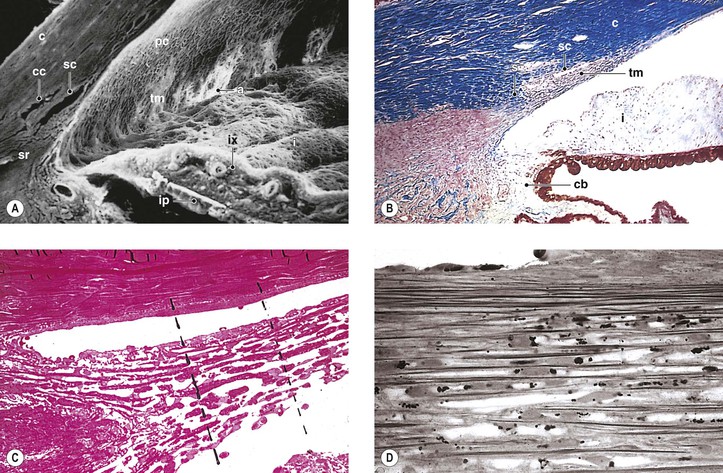

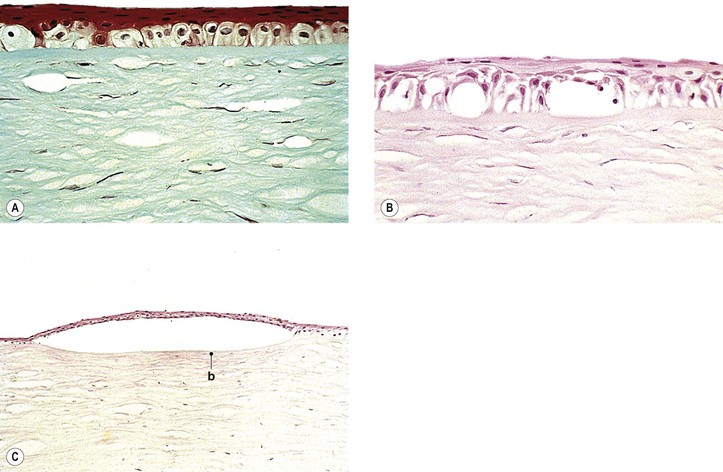
![]()

